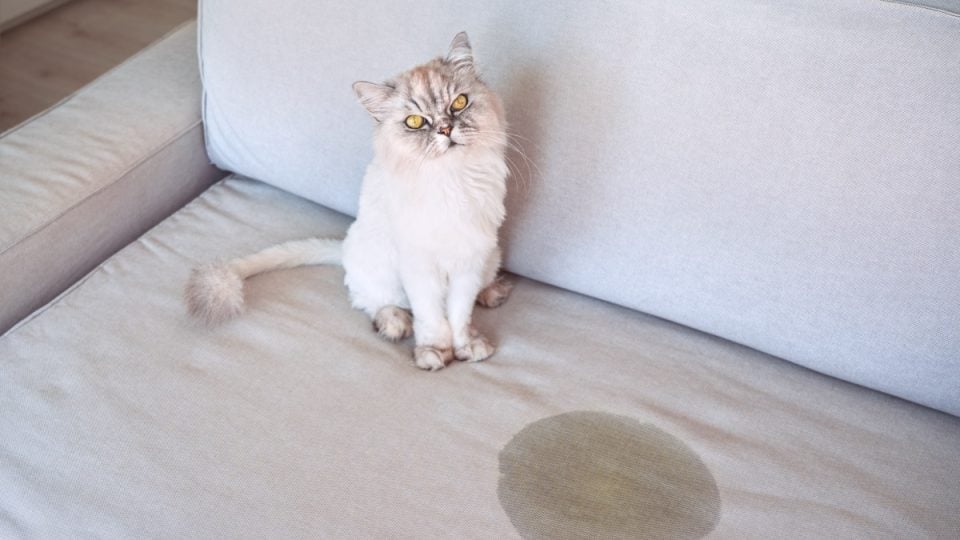- Not a substitute for professional veterinary help.
Litter box accidents can happen. And when they do, it’s important to see your veterinarian, who can diagnose the cause. Luckily, most urinary and defecation issues can be treated when the underlying condition is diagnosed quickly and managed promptly. Although rare, urinary and fecal incontinence are just two of many reasons cat pee or poop ends up outside the litter box. But unlike other litter box accidents, cat incontinence is the involuntary leakage of urine from the bladder. And fecal incontinence means a cat can’t hold their bowel movement in time to make it to the litter box.
In some cases, the underlying cause of incontinence can be treated, and your favorite feline will return to their regular bathroom routine. Other times, incontinence comes with age or a condition that’s not so straightforward to treat. When that’s the case, there are management techniques to help you and your feline live comfortably. First, let’s break down the causes and types of cat incontinence.
11 Reasons for Your Cat’s Incontinence
If you suspect your cat is incontinent, it can be distressing. Luckily, urinary incontinence is relatively rare in cats, representing only 4% of diagnosed cases of feline lower urinary tract disease (or FLUTD). This is a catch-all term to describe any disease affecting any portion of the lower urinary tract from the bladder to the urethra. With help from feline experts, we’ve rounded up the most common causes of feline incontinence. However, only your vet can diagnose your cat’s specific reason for pooping or peeing outside the litter box.
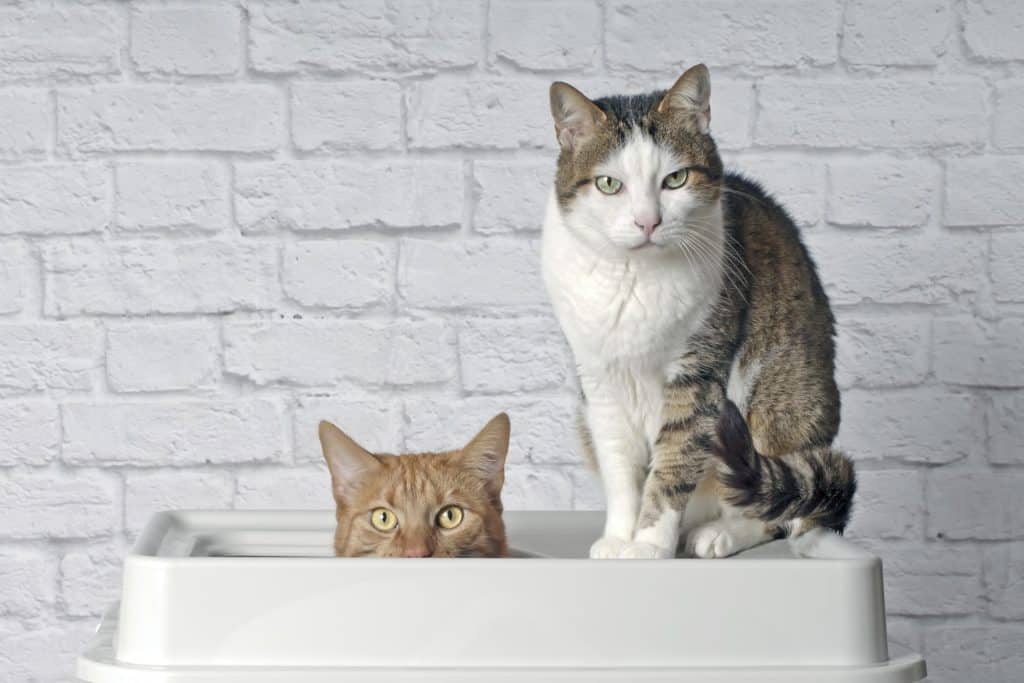
iStock/Lightspruch
Feline idiopathic Cystitis (FIC)
FIC is a common cause of FLUTD in young cats and is caused by stress and can be thought of as an upset bladder. The one- to two-week episode of FIC can be painful and be accompanied by urethral spasms that cause urine to leak.
Additionally, male cats with FIC can develop life-threatening obstructions. So, don’t wait to chat with your vet if you notice any signs of urinary discomfort in your cat.
Urinary tract infection (UTI)
Symptoms of UTIs in cats include straining to urinate, peeing small amounts often, and accidents outside of the litter box. Vet-prescribed antibiotics are the best treatment for cat UTIs. But when left untreated, UTIs can spread, become harder to treat, increase in pain and discomfort, and cause permanent bladder scarring. This leads to incontinence.
Obstruction
Any obstruction can cause a cat to lose control of their bladder. The most common obstructions causing incontinence in cats include scarring of the urethra or bladder, inflammation, abnormal cell growth, kidney stones, or other foreign bodies. A trip to the vet will take care of the obstruction and its symptoms. Typically, your vet will prescribe antibiotics, suggest a diet change, or recommend surgery.
Because they have a longer, narrower urethra than female cats, obstructions are more common in male cats. And while surgery to remove obstructions is lifesaving, that same surgery could result in scarring. The good news: even male cats with scarring have a good prognosis of returning to the litter box.
Diabetes
Peripheral neuropathy is a degenerative disease causing damage to the nerves outside the brain and spinal cord. It affects about 10% of cats with unmanaged diabetes. As a result, cats experience hind leg weakness, loss of bladder and/or bowel control, and, eventually, the inability to walk. However, when caught early and with diabetes management, symptoms can resolve.
Ectopic ureter
Ectopic ureter is one congenital disability that may cause urinary incontinence. When a cat is born with an ectopic ureter, there’s an abnormality in the tube connecting the kidney to the bladder. It can affect one or both ureters. Urine leakage while resting is a common sign. Vet treatment for ectopic ureter includes surgery or a laser procedure.
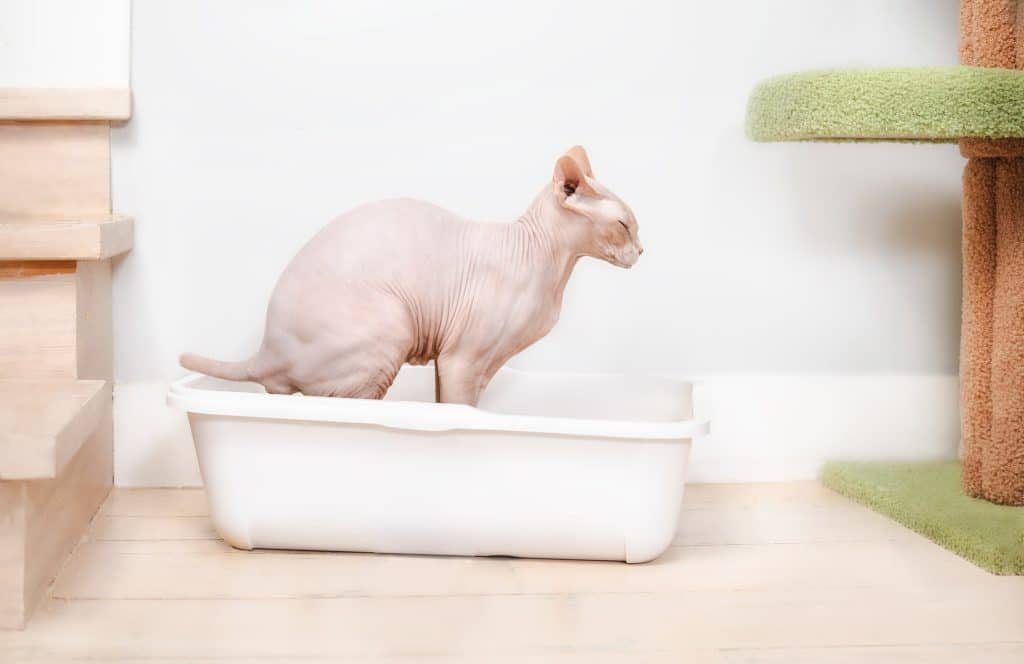
iStock/Petra Richli
Urethral sphincter mechanism incompetence (USMI)
USMI is comparable to stress incompetence in women. Some cases in male and female cats are acquired, while others are congenital. When it’s acquired, USMI is referred to as spay incompetence and is caused by the weakening of the urethra sphincter after spay surgery. Congenital USMI is more common, caused by weak sphincter muscles or abnormalities in the length of the urethra. According to Dr. Michael Kraun, DVM of the Dallas Veterinary Surgical Center, about half of female cats born with USMI will gain bladder control after their first heat cycle.
Trauma, disease, or congenital disabilities affecting the central nervous system (CNS)
The brain and spinal cord comprise the central nervous system (CNS). The CNS plays an essential role in a cat’s urinary and digestive tract function. Therefore, any injury, disease, or spinal defect from the brain to the base of the tail could cause a loss of bladder or bowel control. That includes congenital conditions such as Manx syndrome and epilepsy.
Dr. Curtis Dewey, DVM, an associate professor of neurology and neurosurgery at the Cornell University College of Veterinary Medicine, adds that feline incontinence is often seen in cats experiencing a near miss with a car. “[They] almost escaped being hit but have had their tails run over. This can yank on the nerve roots, and in addition to having a dead tail, a cat that survives is likely to have urinary and fecal incontinence for the rest of its life,” he says.
Surgical complications
Anal sacs are the two tiny glands located just inside the rectum. They contain strong-smell fluid that presses out as a cat poops necessary for territory marking. But your vet will need to intervene when anal sacs don’t express or become infected or impacted. In some persistent or severe cases, that may include surgery on or the removal of the anal sac. Unfortunately, anal sac surgery commonly causes fecal incontinence. Luckily, this common complication is typically temporary.
Anus or rectum diseases
Inflammatory diseases, including colitis and proctitis, abnormal cell growth, and infections, can cause loss of voluntary bowel function. In addition, many diseases of the anus or rectum are characterized by diarrhea that is bloody or mucus-filled.
A mass in the bladder
While rare (1% of all tumors in cats and dogs), feline incontinence may be due to a growth in the bladder or other structural changes in the urethra. In addition to incontinence, signs of abnormal growth in the urinary tract include persistent blood in urine, increased urinary frequency, and painful urination.
Senility
“Incontinence can be seen in senior or geriatric cats because as they age, so do certain muscles that help control these functions,” shares Dr. Julie Andino, DVM, a New York City-based veterinarian at URvet Care. She notes incontinence isn’t the only reason a senior cat might pee or poop outside of their litter box; “cognitive impairment can cause cats to forget where their litter box is and lead to accidents in the home.”
It’s important to first see your vet to rule out any underlying medical issues and to discuss medications that might help. Then, purchase a few more litter boxes, placing them near your cat’s favorite spots for easy access.
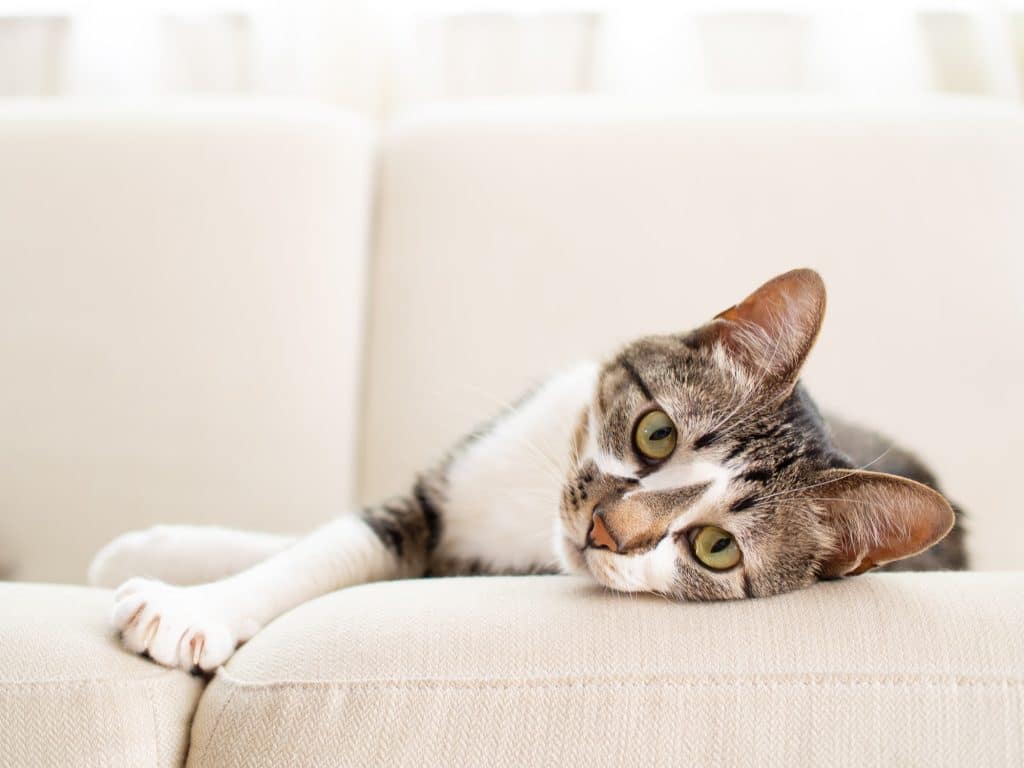
iStock/kaorinne
Types of Feline Incontinence
There are two types of incontinence in cats: urinary incontinence and fecal incontinence. Both mean your cat can’t control what’s happening and require an immediate check-up from your veterinarian for diagnosis, treatment, or an at-home management plan.
Feline Urinary Incontinence
Like the human urinary tract, the cat’s urinary tract includes the kidneys, ureters (the tubes connecting the kidneys to the bladder), bladder, and urethra (the tube urine exits the body through). When cats have urinary incontinence, they can’t hold their pee until they reach the litter box. As a result, pee might dribble without them knowing, or they might have an uncontrollable urge to go.
Causes of a leaky bladder can be congenital (they’re born with it) or acquired (it developed sometime after birth due to disease or injury). It might be neurogenic (neurological-related) or non-neurogenic. And while some cases of incontinence are constant and sudden, others come on intermittently and slowly over time.
But if you notice any of the following signs and symptoms of urinary incontinence in your cat, it’s time to see the vet for relief:
- Urine leakage while resting or lying down
- Urine-soaked genitals
- Excessive licking of the genitals
- Urine dribbling when walking
- Frequent urination
- Pain when urinating
Dr. Andino adds that if you notice your pet has a wobbly walk, they may have suffered nerve damage which could cause incontinence.
Feline Fecal Incontinence
When a cat can’t control the elimination of waste and fecal matter exits or leaks uncontrollably, that’s feline fecal incontinence. Cats have two types of feline fecal incontinence: Reservoir and sphincter incontinence.
Feline reservoir incontinence means a cat cannot store waste in the large bowel. Instead, it’s accompanied by an immediate and uncontrollable urge to poop.
Feline sphincter incontinence is the loss of anal sphincter function due to decreased muscle tone, decreased sensation, or loss of neurological reflexes. Sphincter incontinence is commonly associated with waste leakage or dribbling without awareness.
According to Dr. Andino, signs and symptoms of feline fecal incontinence include:
- Finding pieces of stool around the house
- Pooping outside the litter box
- Straining to poop
- Pooping while walking
- A wobbly gait
Unfortunately, bowel incontinence often leads to unnecessary euthanasia. While there is no one medication to treat feline fecal incontinence, the underlying cause should be diagnosed and treated to relieve uncontrollable bowel movements.
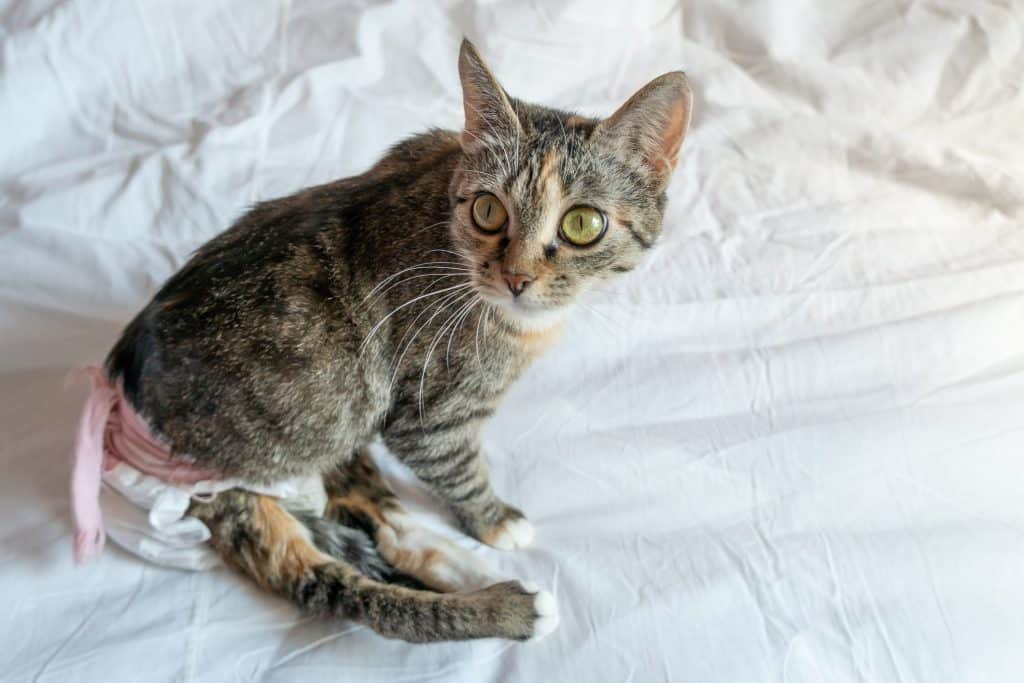
iStock/Olga Ihnatsyeva
Caring For An Incontinent Cat
Struggling to control bodily functions can be scary for a pet and, at times, frustrating for pet parents. But help is just a vet visit away. Dr. Andino says the most important action pet parents can take is to bring their cat to a vet for examination.
There are a lot of underlying causes for feline incontinence; that’s why only your vet can diagnose and treat it. Plus, loss of bodily control isn’t the only reason for inappropriate elimination in cats. To help your vet get to the bottom of the issue, provide any details possible, from a timeline of onset to consistency, frequency, and even a video of elimination events. Regarding tummy troubles and urinary woes, no detail is too little for your vet to consider.
If your vet rules out medical conditions, then litter box issues could be solved with changes at home, like cleaning the litter box more often, reducing stress, or changing the litter box’s location. Cats typically catch on to litter box training quickly, but kittens and rescues might need some help before becoming pros.
Just like no two cats are alike, no two cases of feline incontinence may be identical. However, with personalized care that might include placing more litter boxes around the house, using potty pads and diapers, massaging sore muscles, and bathing your cat, cats can live long and full lives with incontinence.
